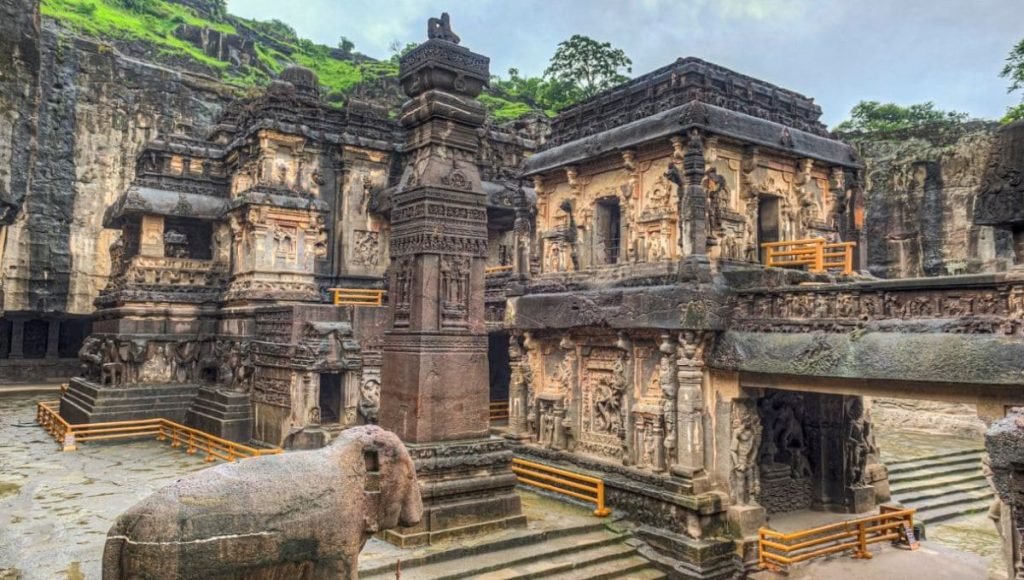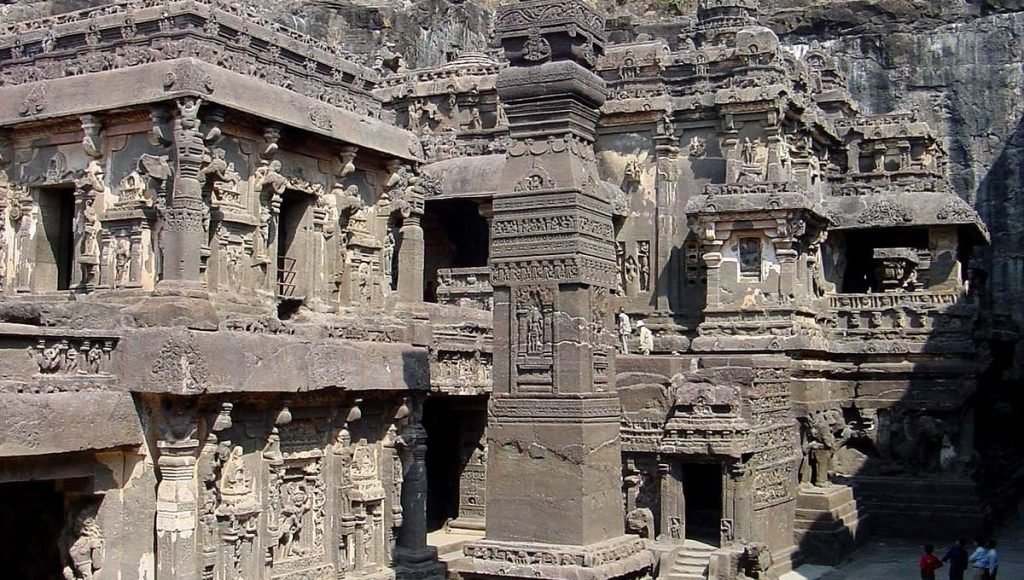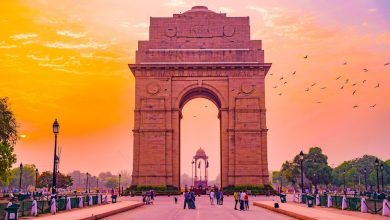
Origin of The Kailasa Temple: One of the biggest monolithic rock-cut shrines can be found in Maharashtra’s Ellora caves, where it is called Kailash Temple. It has a Lord Shiva dedication and is renowned for its exquisite architecture. Despite the fact that the rock face slopes downward from the back to the front of the temple, the top of the superstructure over the sanctuary is 32.6 meters (107 feet) above the level of the court below. It is thought by archaeologists to be made of a single rock.
The greatest of the 34 Buddhist, Jain, and Hindu cave temples and monasteries that make up the Ellora Caves, which stretch for more than two kilometers (1.2 miles) down the site’s sloping basalt cliff, is the Kailasa temple (Cave 16). Most of the temple’s excavation is traditionally credited to the Rashtrakuta king Krishna I (r. c. 756–773) in the eighth century, however, other components were finished later. Pallava and Chalukya architectural influences may be seen in the temple.
Although the murals that formerly graced the temple are now merely vestiges of their original beauty, the temple still has numerous relief and free-standing sculptures on a vast scale that match the architecture. Over two decades were spent carving the entire structure. Even while part of the temple’s history is a little contentious, there is still a tonne of other astounding facts about this ancient marvel.
Origin of The Kailasa Temple
HISTORY OF THE TEMPLE

Various unique architectural and sculptural styles are used in the Kailasa temple. This, together with its comparatively great size, has led some academics to hypothesize that its construction took place across a number of monarchs’ reigns. The Dashavatara cave (Cave 15), which is close to the temple, has a similar aesthetic to some of the temple reliefs. Its construction is generally attributed to the Rashtrakuta king Krishna I (r. 756-773 CE).
An inscription by Krishna’s forefather and nephew Dantidurga (c. 735-756 CE) may be seen in the Dashavatara cave. Based on this, art historian Hermann Goetz postulated in 1952 that the Kailasa temple’s construction started during the reign of Dantidurga. Its initial full construction, which was much smaller than the current temple, was dedicated by Krishna. Goetz says that Dantidurga’s participation in building the temple may have been purposefully repressed because Krishna disregarded Dantidurga’s sons to take the crown after his passing.
Goetz further proposed the theory that the temple was further expanded by the subsequent Rashtrakuta kings based on an analysis of the various architectural styles. Dhruva Dharavarsha, Govinda III, Amoghavarsha, and Krishna III are some of these emperors. Goetz claims that during his invasion of Deccan in the 11th century, the Paramara emperor Bhoja commissioned the elephant-lion frieze on the bottom plinth and added a fresh layer of paintings. Ahilyabai Holkar finally ordered the last layer of the temple’s paintings.
The majority of the temple, according to M. K. Dhavalikar (1982), who also agreed with Goetz that some other elements of the temple complex can be dated to the reigns of succeeding kings, was built during the time of Krishna I. Krishna finished building the main shrine, its gateway, the nandi-mandapa, the lower level, the elephant-lion frieze, the court elephants, and the victory pillars, according to Dhavalikar. Dhavalikar acknowledges that the main structure of the temple appears to have been constructed before the most significant sculpture, which shows Ravana shaking the Kailash mountain.
It’s conceivable that the temple’s name, Kailasa, was inspired by this sculpture because it’s one of the best examples of Indian art. Given that it resembles the Tandav sculpture in the Lankeshvar cave, Dhavalikar hypotheses that this sculpture was created three to four decades after the main shrine was finished. This relief was dated by H. Goetz to the era of Krishna III. Like Goetz, Dhavalikar ascribes some of the temple complex’s other constructions to its subsequent kings.
These include the River Goddess Shrine and the Lankeshwar Cave (possibly constructed during the reign of Govinda III). Dhavalikar further speculates that the excavation of the Dashavatara cave, which was underway under Dantidurga’s rule, was finished during Krishna I’s rule. This explains why the sculptures in the two caves are similar to one another.
STRUCTURE OF THE TEMPLE

It is said by the archeologists that The building was carved out of the mountain by architects working their way down. Archaeologists estimate that between 757 and 783 A.D., more than 200,000 tonnes of volcanic rock were removed by this laborious operation. One of the 34 rock-cut caves in the region is Kailasa Temple. There have been comparable caverns since 300 B.C.
The temple is around 150 feet deep and has a U-shape. The height of Kailasa Temple is three stories. Several Hindu deities are depicted in large stone carvings along the exterior walls. Stories from Lord Shiva’s tale are displayed on two internal flagstaff pillars. Huge carvings in honor of Lord Vishnu, another important Hindu god, are also present. The internal construction has beautiful carvings almost everywhere.
Elephant engravings that point down can be found at the summit. It looks as though an army of enormous stone elephants is supporting the entire temple from the bottom of the main structure. The elephants are gathered around what looks to be the main structure in the temple complex, a 100-foot-tall pillar.
The complex has stunning architectural characteristics as well as cosmological components. Some academics believe that the temple complex’s architectural layout represents a journey from the physical to the divine, from the celestial to the heavenly, and from matter to consciousness.
The primary entrance is represented by the Gopuram, or entrance gate, which also serves as a metaphor for the transition from the secular to the sacred. There are fewer distractions and a person is moving closer to the divine world as the size, volume, and space of the hall get smaller and the light gets weaker as one passes from one mandapa to the next.
The Kailash temple in Ellora is a location where both brilliant architectural design and spiritualism coexist. No other Indian kingdom could build a building as magnificent as the Kailasa Temple in Ellora, according to consensus. Although on a smaller scale, the Jainas’ attempt to accomplish a comparable achievement resulted in Cave 30, an incomplete excavation that went by the name Chhota Kailasa. The temple was difficult to build, and it was practically hard to take it down. The Mughal ruler Aurangzeb once tried to destroy the shrine and test its sanctity. According to medieval sources, as a result, the majority of the paintings were destroyed and the carvings sustained serious damage.
ALSO READ:






